'Ma Rainey's Black Bottom' Costume Designer on Dressing Viola Davis and Chadwick Boseman
- Oops!Something went wrong.Please try again later.
- Oops!Something went wrong.Please try again later.
- Oops!Something went wrong.Please try again later.
The legendary Ann Roth talks creating the titular character's bold, meaningful performance looks and fussing with the late, beloved actor's fedora during filming.
"She had every intention of treating herself like a queen," says "Ma Rainey's Black Bottom" costume designer Ann Roth, on a call, about the titular character (played by Oscar-winner Viola Davis) and her audacious on- and off-stage style.
While anxiously awaiting a Nor'easter, the legendary Oscar- and Tony-winner hunkered down to discuss her work in two-time Tony-winning director George C. Wolfe's movie adaptation of the August Wilson play. As part of the 10-series "American Century Cycle" chronicling the 20th Century African American experience, the story (mostly) takes place in Chicago on a sweltering summer day in 1927. Ma Rainey and her band, including ambitious coronet player Levee (the beloved Chadwick Boseman, in his final role), arrive in the Windy City from their home base of Georgia to record a few of her hits.
The only of Wilson's openly queer characters, Ma is based on the real-life blues singer and Paramount Records artist who, as a trailblazer in the era, discussed LGBTQ+ themes in her music. (Rainey famously flashed her smile full of gold teeth and regularly brought the house down in her signature necklace jangling with 20 gold dollar coins, as also depicted in the opening sequences of the film.)
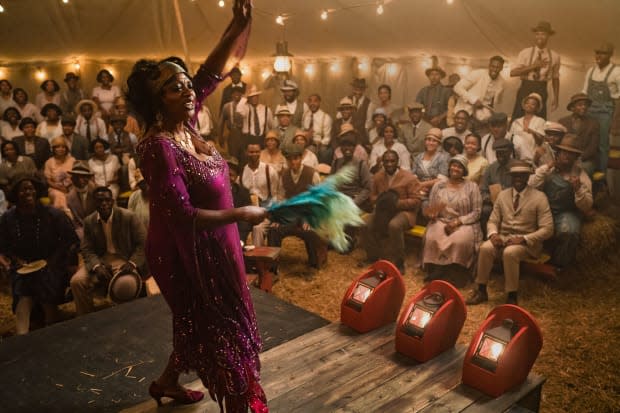
We first see Ma on stage, for one of her traveling tent concerts, in Barnesville, Georgia. The venue is packed with people, turned out in their best; she's wearing a flowing berry-red dress with a scalloped hem, intricate beading on the bodice and dazzling sequins dripping down the silhouette (above). "Her stuff was expensive," says Roth, whose packed credits include iconic films and moments like Jane Fonda's over-the-knee boots in "Klute" (and the shaggy haircut that Roth says she spontaneously "dragged" the actor to get), Matt Damon's chartreuse short-shorts in "The Talented Mr. Ripley" and Meryl Streep's authoritative caftan in "The Post." (She also won her Oscar for "The English Patient.")
Ma and her band's ensuing trip to Chicago takes place roughly a decade into The Great Migration. Over six million African Americans headed from rural areas in the South to urban centers in the North, Midwest and West, seeking job opportunities and leaving Jim Crow segregationist laws and brutal anti-Black racism (which, as we know in 2020, is a country-wide American pandemic). In Chicago, the "Mother of the Blues" hits the stage, mini-skirted backup dancers in tow, wearing a lush, sparkling blue velvet gown with sequin embellishments, high leg slits and long fringe that sways as she moves (below), custom-built by Roth.
The costume designer — who previously worked with Wolfe on Broadway ("Shuffle Along or, the Making of the Musical Sensation of 1921 and All That Followed," "The Iceman Cometh," "Gary: a Sequel to Titus Andronicous") — collaborated with Davis on accurately distilling Ma Rainey's ownership of her sexuality and success through her wardrobe. In the production notes, the actor explained: "Usually Ma Rainey and how she looks has been greatly stereotyped in cinematic history and in life. The Black woman is always dark, fat, funny, can sing and is really not sexualized in any way that is dangerous. But that's not my understanding of women like that."
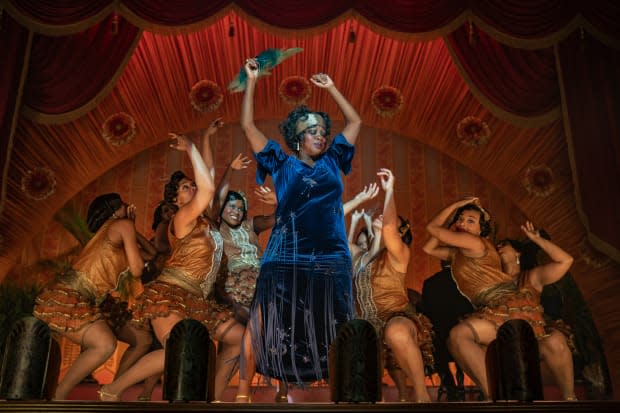
"Ma is my Auntie Joyce, my Aunt Letha, who were highly sexual and the most beautiful women I ever seen in my life," Davis continued. "They were stylish. I didn't want Ma to physically look like she was apologizing for herself. I wanted her to switch. If those breasts were hanging out like that? They just hung out. She was unapologetic about her sexuality. I had to honor that."
Roth also created her own backstory about how Ma amassed her bold wardrobe that especially turns heads in Chicago. "She's not a woman from the North, she's a Southern girl — and a traveling girl — and I pretended that her clothes were made by a woman in Mississippi," she says. "I just made that up, and that's what I decided."
Ma anticipates causing a stir with the snobbish crowd in the posh Black Chicago hotel as she heads to the recording studio flanked by her entourage, including younger girlfriend Dussie (Taylour Paige). "She wanted to look better than [her former mentee-turned-competitor] Bessie Smith, and she wanted to look better than those ladies in that tea room in Chicago," explains Roth.
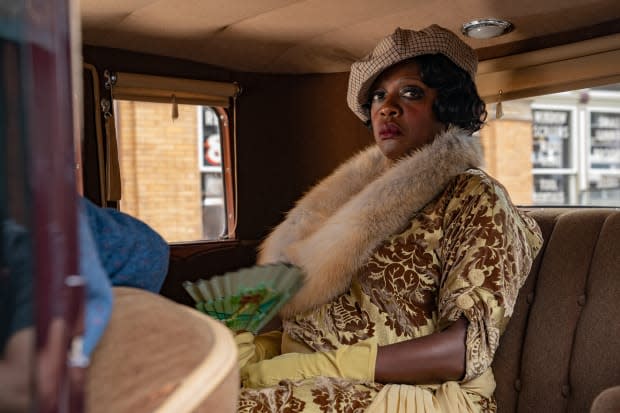
Ma saunters down the stairs to glares and jaw-drops in a gold and chocolate velvet brocade dress (above and top), accessorized with yellow gloves and a window pane plaid newsboy cap. She brazenly throws a luxurious mink stole around her neck, as she slow-walks past her disapproving audience. "The fur in this terrible heat of Chicago," notes Roth.
Ma's intentionally lavish wardrobe also serves as armor to help her navigate often hostile white spaces, including the recording studio run by Sturdyvant (Jonny Coyne), who's not the first white producer to co-opt Black music and call it his own. "She knew that she had to look better than anybody and her idea of what was better had a certain showbiz quality and not what the quiet upper class women were wearing," Roth says.
Boseman, who tragically lost his battle with colon cancer in August at the age of 43, gives a heartbreaking, powerhouse performance as Levee, who's chasing his songwriting dreams in the big city while confronting his own direct and generational racial trauma.
Like bandmates Cutler (a trombone player and de facto leader of the group, played by Colman Domingo), Slow Drag (bassist, played by Michael Potts) and Toledo (pianist, played by Glynn Turman), Levee ventures down Chicago's Halsted Street wide-eyed and outfitted in a trusty three-piece suit, consisting of a wide-pinstriped jacket, a gray vest and trouser with the most subtle glen plaid weave, a blue- and white-striped button-down and square graphic-print tie.
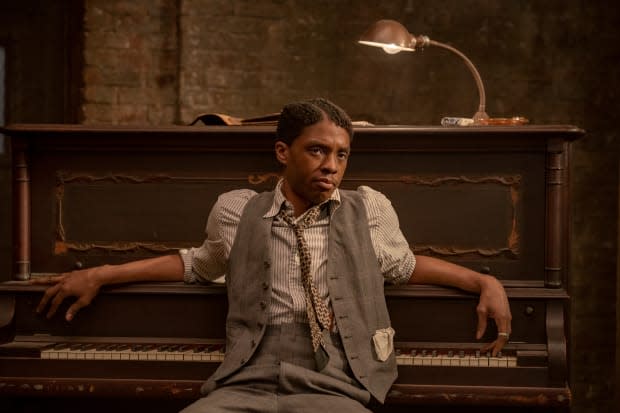
"They have to wear a shirt and a tie and they travel on buses and on trains and they travel a lot and their clothes take a beating," explains Roth of the quartet's travel ensembles, worn for the majority of the film. "If they perform at night, those suits either hang over the back of a chair in a rooming house somewhere. They don't have a wardrobe lady and they don't have a valet. Some of them take their pants off, folded them and put them between the mattress and the bedspring. That often happened. It takes the crease out!"
Roth began designing Levee's suit remotely, off of Boseman's measurements. But once the two met in person for fittings, they immediately connected — especially through character building discussions about Levee's dapper costume, which supports him through the film and his intense monologues.
"He got into it," says Roth. "He enjoyed the process of [determining the origin of] the clothes: 'Where did they come from? Who paid for them? How much did they cost? Where did he pick them up? Tennessee? Alabama? Arkansas? How did the pants fit?' All that. [Levee] wanted to look good. And [Boseman] was very responsive; a very, very good actor to play with."
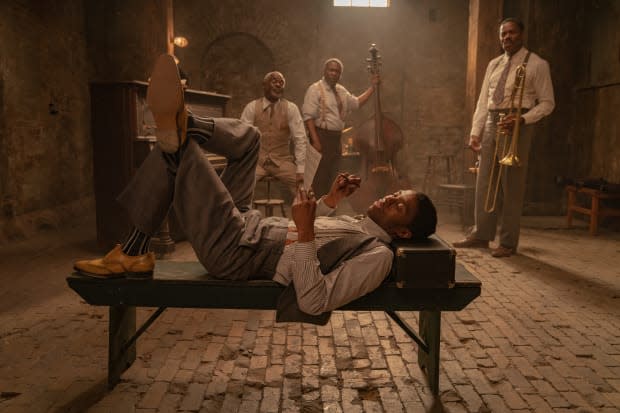
To fit into his new environment and help manifest his vision (and not wear "clodhoppers," as he derides Toledo's scuffed black oxfords), Levee splurges on a shiny pair of golden pointy wingtips he spots in a shop window (above). In the production notes, Roth wrote about wanting them to be yellow: "In that period, most men had a pair of black shoes and a brown pair. When you went to church, those were the black shoes, and the brown shoes were working shoes, but yellow shoes were extraordinary. You had to be a high-stepper to have them, or to wear them, or to pay for them."
Related Articles:
How Ruth E. Carter Went From Costuming Her College Plays to Dressing 'Marshall' and 'Black Panther'
The Costume, Hair and Makeup in Marvel's 'Black Panther' Are a Celebration of Black Heritage and Culture
Paul Tazewell Tracks His Career From Midwestern Theater Student to Costume Designing for 'Hamilton' and 'Harriet'
Roth has an ongoing "secret stash" of the footwear, so landing on the jaunty shoe came naturally, along with designing all the natty suits. ("I'm a very old lady," says the 89-year-old, who also has two upcoming movies in pre-production. "I've been doing this a long, long time.") Levee's proud new purchase draws plenty of closeups during Boseman's physicality-heavy performance, featuring bluesy fancy footwork.
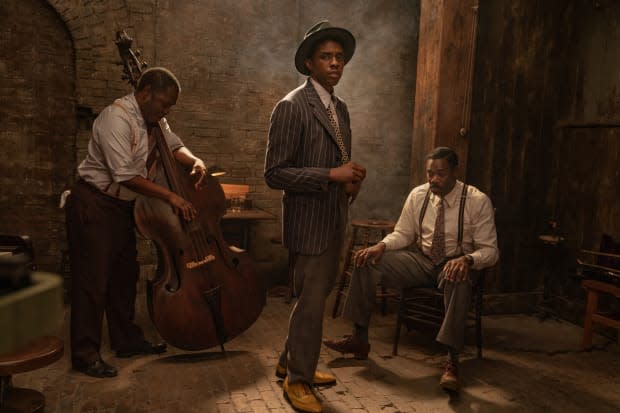
Like Ma's statement fur and gloves, the layers of the band's suits allow for organic costume changes to denote new scenes and progress the story, which mostly takes place in two rooms in the literally-named Hot Rhythm Recordings. Levee's debonair fedora also helps advance the plot and ended up being a push-and-pull between Roth and Boseman — not unlike Ma's and Levee's debate over which version of "Black Bottom" to record.
"His hat was a big deal with him. Every time he put that hat on, I would go in and change it on his head. Of course, that’s not something you do to an actor before they’re about to perform," says Roth. "But I told him, 'This is the way I want the hat on.' I loved him and he loved me, but he invariably would try to put that hat on the way I didn't want it. But I loved that he knew how to wear a hat. It's very rare."
Never miss the latest fashion industry news. Sign up for the Fashionista daily newsletter.
